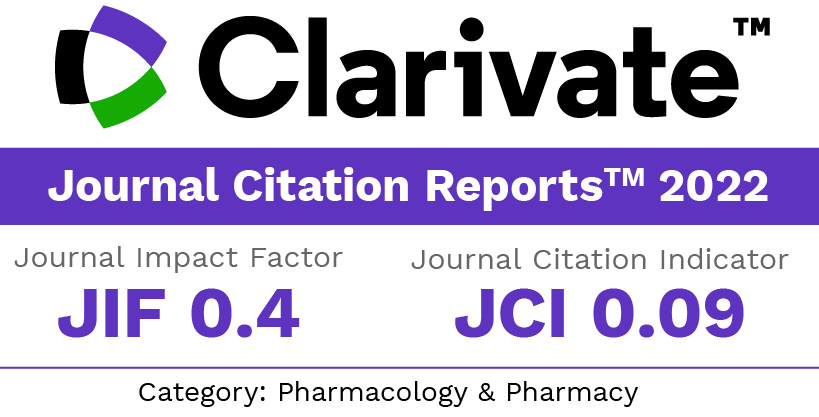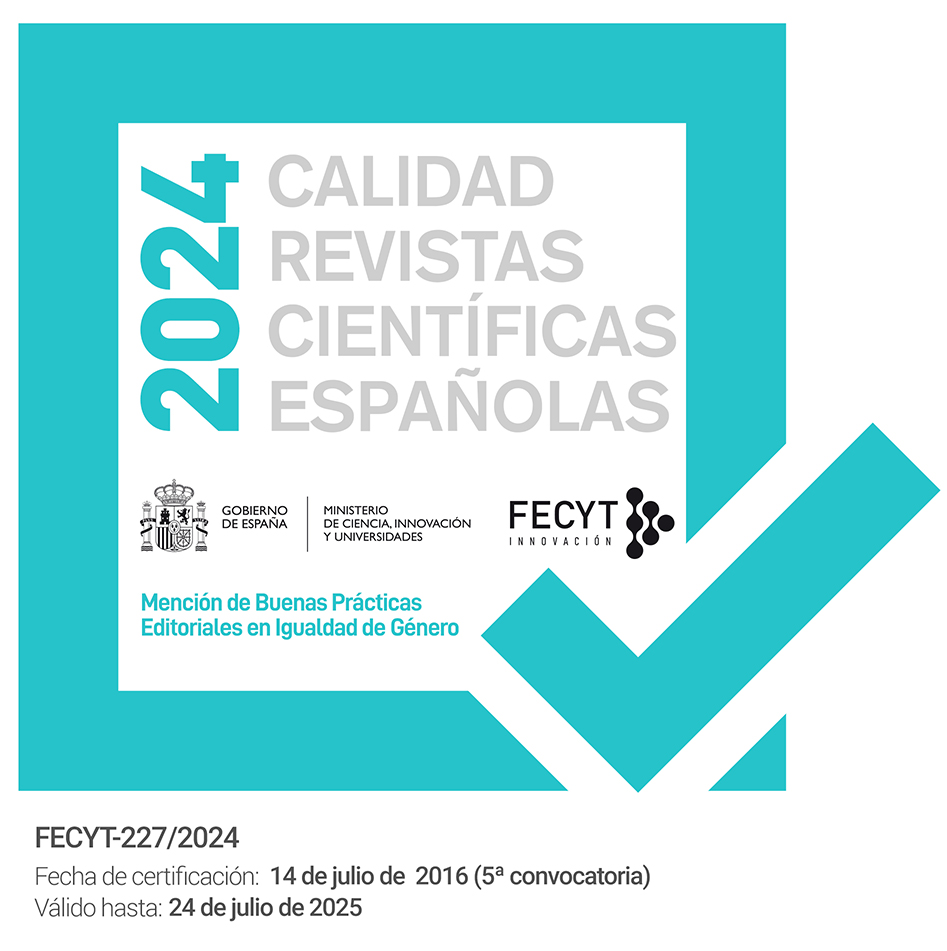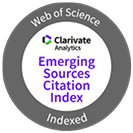Cytotoxicity and Wound Healing Effect of Camphor Menthol Based Natural Deep Eutectic Solvents Against Human Epidermoid Carcinoma (A431) Cell Line
DOI:
https://doi.org/10.30827/ars.v66i4.34110Keywords:
Camphor; menthol; natural deep eutectic solvent; A431 cell line; MTT assay; in vitro wound healing activityAbstract
Introduction: Skin cancer is a serious health issue and finding effective treatments is crucial. This study investigated the effects of camphor-menthol based natural deep eutectic solvent on human epidermoid carcinoma A431-cells, a model for skin cancer.
Method: The 3-(4,5-dimethylthiazol-2-yl)-2,5-diphenyltetrazolium bromide assay was performed to assess cell viability and cytotoxicity by measuring absorbance at 570 nm. The absorbance at 570 nm was measured to determine the optical density values, and cell viability was calculated as a percentage. Additionally, an in vitro scratch assay was performed to evaluate the impact of camphor-menthol based natural deep eutectic solvent on cell migration.
Results: The results revealed a concentration-dependent decrease in both optical density values and cell viability, with an inhibitory concentration of 311.7 µg/ml. The treated group exhibited a significant reduction in wound area compared to the control, suggesting potential antimigratory effects. Since cell migration is key to cancer spread, this could be an important finding.
Conclusion: In conclusion, these findings highlight the cytotoxic and migration-inhibiting properties of camphor-menthol based natural deep eutectic solvent, supporting its potential as a therapeutic agent against skin cancer. These findings highlight the potential of natural compounds in cancer treatment. More research is needed to understand how camphor-menthol based natural deep eutectic solvent works and to confirm these results in more complex biological systems.
Downloads
References
Wang M, Gao X, Zhang L. Recent Global Patterns in Skin Cancer Incidence, Mortality, and Prevalence. Chin Med J. 2025;138(2):185–192. https://doi.org/10.1097/CM9.0000000000003416
Griffiths SK. The Effects of Cis-9, Trans-11 Conjugated Linoleic Acid on the Proliferation of A431 Epidermoid Carcinoma Cells. (Master’s thesis), University of Chester, United Kingdom, 2018. https://chesterrep.openrepository.com/handle/10034/621872 (accessed 2025-03-05).
Niehus SE, Tran DDH, Mischak M, Koch A. Colony-Stimulating Factor-1 Receptor Provides a Growth Advantage in Epithelial Cancer Cell Line A431 in the Presence of Epidermal Growth Factor Receptor Inhibitor Gefitinib. Cellular Signalling. 2018;51:191–198. https://doi.org/10.1016/j.cellsig.2018.07.014
Voloshin N, Tyurin-Kuzmin P, Karagyaur M, Akopyan Z, Kulebyakin K. Practical Use of Immortalized Cells in Medicine: Current Advances and Future Perspectives. Int J Mol Sci. 2023:24(16):12716. https://doi.org/10.3390/ijms241612716
Kaur G, Dufour JM. Cell Lines: Valuable Tools or Useless Artifacts. Spermatogenesis. 2012;2(1):1–5. https://doi.org/10.4161/spmg.19885.
Monteiro H, Paiva A, Duarte ARC, Galamba N. Structure and Dynamic Properties of a Glycerol–Betaine Deep Eutectic Solvent: When Does a DES Become an Aqueous Solution? ACS Sustainable Chem Eng. 2022;10(11): 3501–3512. https://doi.org/10.1021/acssuschemeng.1c07461
Raja Sekharan T, Tamilvanan S, Rajadurai S, Ibrahim SM, Kavipriya K. Development of Ibuprofen-Loaded Emulsion from Eutectic Mixture and Eudragit RL 100. PharmaTutor. 2019;7(7):7–13.
Raja Sekharan T, Margret Chandira R, Rajesh SC, Tamilvanan S, Vijayakumar CT, Venkateswarlu BS. Stability of Curcumin Improved in Hydrophobic Based Deep Eutectic Solvents. Res J Pharm Technol. 2021;14(12):6430–6436. https://doi.org/10.52711/0974-360X.2021.01112
Raja Sekharan T, Margret Chandira R, Rajesh SC, Tamilvanan S, Vijayakumar CT, Venkateswarlu BS. pH, Viscosity of Hydrophobic Based Natural Deep Eutectic Solvents and the Effect of Curcumin Solubility in It. Biointerface Res Appl Chem. 2021;11(6):14620–14633. https://doi.org/10.33263/BRIAC116.1462014633
Raja Sekharan T, Katari O, Ruhina Rahman SN, Pawde DM, Goswami A, Margret Chandira R, Tamilvanan S. Neoteric Solvents for the Pharmaceutical Industry: An Update. Drug Discov Today. 2021;26(7):1702–1711. https://doi.org/10.1016/j.drudis.2021.03.005
Raja Sekharan T, Margret Chandira R, Rajesh SC, Tamilvanan S, Vijayakumar CT, Venkateswarlu BS. Deep Eutectic Solvents as an Alternate to Other Harmful Solvents. Biointerface Res Appl Chem. 2022;12(1):847–860. https://doi.org/10.33263/BRIAC121.847860
Paiva A, Craveiro R, Aroso I, Martins M, Reis RL, Duarte ARC. Natural Deep Eutectic Solvents – Solvents for the 21st Century. ACS Sustainable Chem Eng. 2014;2(5):1063–1071. https://doi.org/10.1021/sc500096j
Kowalski S, Karska J, Tota M, Skinderowicz K, Kulbacka J, Drąg-Zalesińska M. Natural Compounds in Non-Melanoma Skin Cancer: Prevention and Treatment. Molecules, 2024;29(3):728. https://doi.org/10.3390/molecules29030728
Singh H, Kumar R, Mazumder A, Salahuddin, Yadav RK, Chauhan B, Abdulah MM. Camphor and Menthol as Anticancer Agents: Synthesis, Structure-Activity Relationship and Interaction with Cancer Cell Lines. Anti-Cancer Agents in Medicinal Chemistry-Anti-Cancer Agents 2023;23(6):614–623. https://doi.org/10.2174/1871520622666220810153735
Ekambaram R, Saravanan S, Selvam N, Dharmalingam S. Statistical Optimization of Novel Acemannan Polysaccharides Assisted TiO2 Nanorods Based Nanofibers for Skin Cancer Application. Carbohydr Polym Technol App. 2021;2:100048. https://doi.org/10.1016/j.carpta.2021.100048
Khan F. Chemical Profiling and Toxicological Assessment of Atmospheric Aerosol Using Human Lung Cells, University of North Carolina at Chapel Hill, USA, 2021. https://rcin.org.pl/ichf/Content/233754/Khan%20Faria%20PDF.pdf (accessed 2025-03-08).
Rolke W, Gongora CG. A Chi-Square Goodness-of-Fit Test for Continuous Distributions against a Known Alternative. Comput Stat. 2021;36(3):1885–1900. https://doi.org/10.1007/s00180-020-00997-x
Bahar E, Yoon H. Modeling and Predicting the Cell Migration Properties from Scratch Wound Healing Assay on Cisplatin-Resistant Ovarian Cancer Cell Lines Using Artificial Neural Network. Healthcare. 2021;9(7): 911. https://doi.org/10.3390/healthcare9070911
Benov L. Improved Formazan Dissolution for Bacterial MTT Assay. Microbiol Spectr. 2021;9(3):e01637-21. https://doi.org/10.1128/spectrum.01637-21
Cappiello F, Casciaro B, Mangoni MLA. Novel In Vitro Wound Healing Assay to Evaluate Cell Migration. J Vis Exp. 2018;133: 56825. https://doi.org/10.3791/56825
Ikegame S, Siddiquey MNA, Hung CT, Haas G, Brambilla L, Oguntuyo KY, Kowdle S, Chiu HP, Stevens CS, Vilardo AE, Edelstein A, Perandones C, Kamil JP, Lee B. Neutralizing Activity of Sputnik V Vaccine Sera against SARS-CoV-2 Variants. Nat Commun 2021;12(1):4598. https://doi.org/10.1038/s41467-021-24909-9
Downloads
Published
How to Cite
Issue
Section
License
Copyright (c) 2025 Raja Sekharan, Tamilvanan Shunmugaperumal, Krishna Reddy

This work is licensed under a Creative Commons Attribution-NonCommercial-ShareAlike 4.0 International License.
The articles, which are published in this journal, are subject to the following terms in relation to the rights of patrimonial or exploitation:
- The authors will keep their copyright and guarantee to the journal the right of first publication of their work, which will be distributed with a Creative Commons BY-NC-SA 4.0 license that allows third parties to reuse the work whenever its author, quote the original source and do not make commercial use of it.
b. The authors may adopt other non-exclusive licensing agreements for the distribution of the published version of the work (e.g., deposit it in an institutional telematic file or publish it in a monographic volume) provided that the original source of its publication is indicated.
c. Authors are allowed and advised to disseminate their work through the Internet (e.g. in institutional repositories or on their website) before and during the submission process, which can produce interesting exchanges and increase citations of the published work. (See The effect of open access).























